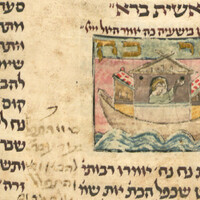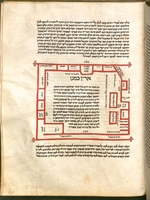Hebrew Bible commentaries
Date:
1232/33
Location or Findspot (Modern-Day Country):
Germany
Medium:
Parchment
Dimensions:
39 × 28.5 cm
Description:
This unfinished thirteenth-century manuscript includes a biblical commentary by the Jewish textual and legal authority Rabbi Solomon ben Yitzhak, known by the acronym Rashi (1040–1105). It was originally intended to include decorative letters and borders, over seventy narrative illuminations at the heads of biblical books and weekly Torah readings, sixteen decorative pages at the ends of biblical books, and a full-page image of the menorah.
The project was commissioned by a Jewish patron (Joseph ben Moses) and was to be undertaken by the Jewish scribe Solomon ben Samuel and illuminators in a Christian workshop. While the illuminators worked on the narrative images (fifteen of which were completed, and many of which still show traces of the Latin instructions), the scribe was responsible for the text and two renditions of diagrammatic maps.
Unlike the narrative illustration in the manuscript, for which images have been set off within rectangular borders, the map of the Land of Canaan serves as a kind of diagrammatic border that encloses text. The ornament is kept to a minimum and there are no figurative elements. The diagram serves only to convey relative positions, and it avoids figuration or any attempts to attribute fixed appearances. Although this mode differs from that of the extensive narrative images, both appear in the same deluxe manuscript. In the context of a biblical commentary, the single patron perceived value in both.
Relevant Primary Sources
The project was commissioned by a Jewish patron (Joseph ben Moses) and was to be undertaken by the Jewish scribe Solomon ben Samuel and illuminators in a Christian workshop. While the illuminators worked on the narrative images (fifteen of which were completed, and many of which still show traces of the Latin instructions), the scribe was responsible for the text and two renditions of diagrammatic maps.
Unlike the narrative illustration in the manuscript, for which images have been set off within rectangular borders, the map of the Land of Canaan serves as a kind of diagrammatic border that encloses text. The ornament is kept to a minimum and there are no figurative elements. The diagram serves only to convey relative positions, and it avoids figuration or any attempts to attribute fixed appearances. Although this mode differs from that of the extensive narrative images, both appear in the same deluxe manuscript. In the context of a biblical commentary, the single patron perceived value in both.
Relevant Primary Sources
Relevant Textbook Chapter(s):
Introduction,
8
Repository and Online Resources:
• Flip through the manuscript on the website of Munich's Bayerische Staatsbibliothek.
• Read about the Hebrew and Yiddish collection of the Bayerische Staatsbibliothek.
Image Credits:
Bayerische Staatsbibliothek, Munich



